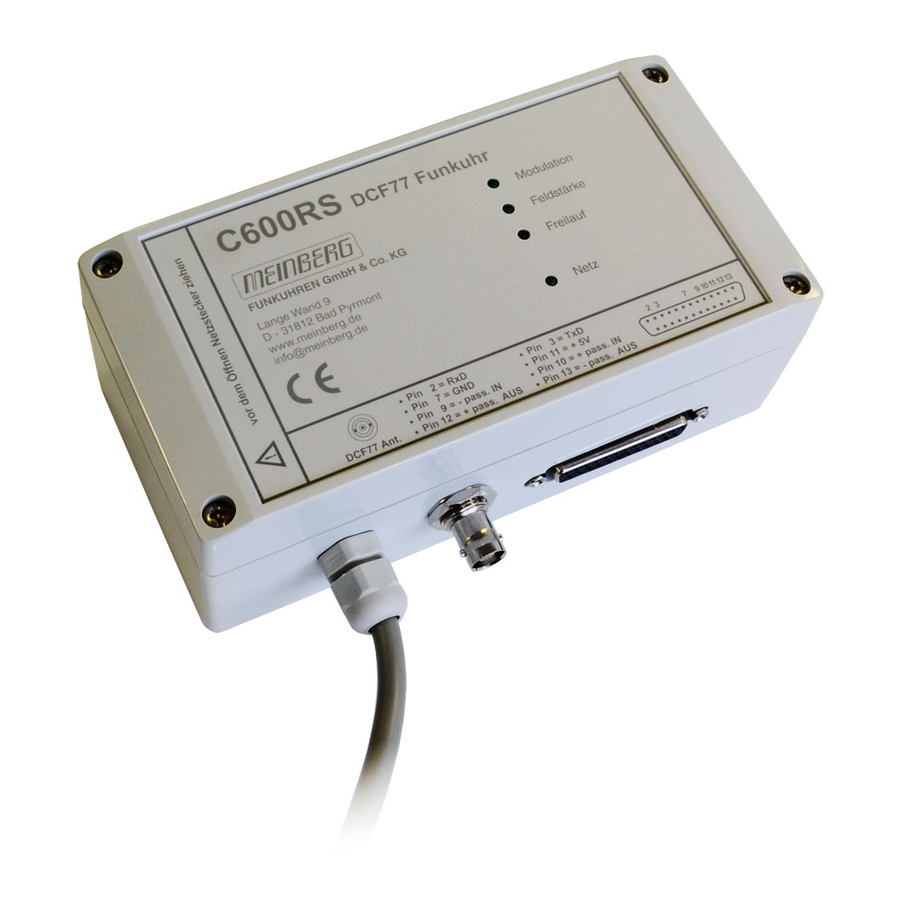
Table of Contents
Advertisement
Quick Links
Advertisement
Table of Contents

Summary of Contents for Meinberg DCF77 PCI511
- Page 1 Technical Information Operating Instructions DCF77 PCI511...
-
Page 2: Impressum
Impressum Meinberg Funkuhren GmbH & Co. KG Lange Wand 9 D-31812 Bad Pyrmont Phone: ++49 52 81 - 9309-0 Fax: ++49 52 81 - 9309-30 Internet: http://www.meinberg.de Email: info@meinberg.de September 16, 2009... -
Page 3: Table Of Contents
Installing the PCI511 in your computer ..........9 Aligning the antenna ................10 Technical specifications ..............12 Format of the Meinberg Standard time string ......14 Firmware updates ..............15 Replacing the lithium battery ..........15 CE label ..................15... -
Page 4: Content Of The Usb Stick
If the present delivered stick doesn’t include a driver program for the operating system used, it can be downloaded from: http://www.meinberg.de/english/sw/ On the USB stick there is a file called „readme.txt“, which helps installing the driver... -
Page 5: General Information About Dcf77
General information about DCF77 The radio clocks made by Meinberg receive the signal from the long wave transmit- ter DCF77. This long wave transmitter installed in Mainflingen near Frankfurt/ Germany transmits the reference time of the Federal Republic of Germany. This time reference is either the Central European Time (Mitteleuropäische Zeit, MEZ) or the... -
Page 6: Overview
If the present delivered diskette doesn’t contain a driver program for the operating system used, it can be downloaded from: http://www.meinberg.de/english/sw/ Pulse outputs The radio clock PCI511 generates pulses whenever a new second (P_SEC) or a new minute (P_MIN) begins. -
Page 7: Block Diagram Pci511
Block diagram PCI511... -
Page 8: Connectors And Leds In The Rear Panel
This port can not be used as serial port for the computer. Instead, the clock uses the port to send out Meinberg's standard time string in order to control an external display or some other external device. The string is sent out once per second, once per minute or if requested by an incoming ASCII „?“. -
Page 9: Pin Assignments Of The 9 Pin Connector
Pin assignments of the 9 pin connector When the clock is being shipped, only the signals needed for the serial port are gated to their pins at the 9 pin connector. If another signal shall be available outside the computer, the corresponding lever of the DIL switch on the board must be set to the ON position to connect that signal to its associated pin. -
Page 10: Aligning The Antenna
Aligning the antenna Generally, the exact alignment of the antenna is important. It has to be placed in longitudinal direction to the transmitter (Frankfurt), see arrow printed on the label of the antenna. A distance of several meters to TV- or computer monitors, to computers or microprocessor boards should be kept. - Page 11 The monitor program displays the following window: modulation field strength acoustig modulation signal on/off...
-
Page 12: Technical Specifications
Technical specifications RECEIVER: Direct conversion quadrature receiver with automatic gain control Bandwidth: approx. 20 Hz ANTENNA: Active external ferrite antenna in a plastic case Length of the cable: up to more than 100m Standard: BNC type connector, 5m of RG174 cable Outdoor: N type connector, RG58 cable RF AMPLITUDE,... - Page 13 8N1, 7E2, 8N2, or 8E1 Mode of Operation: send string per second, per minute, after request ´?´ received Output String: Meinberg standard time string (described below) PULSE- OUTPUTS: Pulses every second (PPS) with TTL- and RS232-level, pulse duration 100 msec, active high...
-
Page 14: Format Of The Meinberg Standard Time String
Format of the Meinberg Standard time string The Meinberg Standard time string is a sequence of 32 ASCII characters starting with the STX (start-of-text) character and ending with the ETX (end-of-text) charac- ter. The format is: <STX>D:dd.mm.yy;T:w;U:hh.mm.ss;uvxy<ETX> The letters printed in italics are replaced by ASCII numbers whereas the other characters are part of the time string. -
Page 15: Firmware Updates
Firmware updates Whenever the on-board software must be upgraded or modified, the new firmware can be downloaded to the internal flash memory via the radio clock's serial port COM0. There is no need to open the computer case and insert a new EPROM. If the button behind a hole in the rear slot cover is pressed twice, a bootstrap loader is activated and waits for instructions from the serial port COM0. -
Page 16: Declaration Of Conformity
Declaration of Conformity Hersteller Meinberg Funkuhren GmbH & Co. KG Auf der Landwehr 22 Manufacturer D-31812 Bad Pyrmont erklärt in alleiniger Verantwortung, daß das Produkt declares under its sole responsibility, that the product DCF77 Funkuhr Produktbezeichnung Product Name PCI511 Modell / Typ Model Designation auf das sich diese Erklärung bezieht, mit den folgenden Normen übereinstimmt...



Need help?
Do you have a question about the DCF77 PCI511 and is the answer not in the manual?
Questions and answers